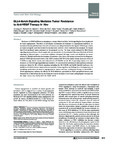Delta-like 4 Notch ligand regulates tumor angiogenesis, improves tumor vascular function, and promotes tumor growth in vivo.
| dc.contributor.author | Li, J-L | en |
| dc.contributor.author | Sainson, RCA | en |
| dc.contributor.author | Shi, W | en |
| dc.contributor.author | Leek, R | en |
| dc.contributor.author | Harrington, LS | en |
| dc.contributor.author | Preusser, M | en |
| dc.contributor.author | Biswas, S | en |
| dc.contributor.author | Turley, H | en |
| dc.contributor.author | Heikamp, E | en |
| dc.contributor.author | Hainfellner, JA | en |
| dc.contributor.author | Harris, AL | en |
| dc.date.accessioned | 2017-11-27T15:59:49Z | |
| dc.date.available | 2017-11-27T15:59:49Z | |
| dc.date.issued | 2007-12-01 | en |
| dc.identifier.uri | http://hdl.handle.net/10026.1/10302 | |
| dc.description.abstract |
The vascular endothelial growth factor (VEGF) plays a key role in tumor angiogenesis. However, clinical trials targeting the VEGF pathway are often ineffective, suggesting that other factors/pathways are also important in tumor angiogenesis. We have previously shown that the Notch ligand Delta-like 4 (DLL4) is up-regulated in tumor vasculature. Here, we show that DLL4, when expressed in tumor cells, functions as a negative regulator of tumor angiogenesis by reducing the number of blood vessels in all five types of xenografts, but acts as a positive driver for tumor growth in two of them (human glioblastoma and prostate cancer). The growth of in vivo models was not related to the effects on growth in vitro. DLL4 expressed in the tumor cells activated Notch signaling in host stromal/endothelial cells, increased blood vessel size, and improved vascular function within tumors. The promotion of tumor growth was, to some extent, due to a reduction of tumor hypoxia and apoptosis. DLL4-expressing tumor cells responded to anti-VEGF therapy with bevacizumab. A soluble form of DLL4 (D4ECD-Fc) blocked tumor growth in both bevacizumab-sensitive and bevacizumab-resistant tumors by disrupting vascular function despite increased tumor vessel density. In addition, we show that DLL4 is up-regulated in tumor cells and tumor endothelial cells of human glioblastoma. Our findings provide a rational basis for the development of novel antiangiogenic strategies via blockade of DLL4/Notch signaling and suggest that combined approaches for interrupting both DLL4 and VEGF pathways may improve antiangiogenic therapy. | en |
| dc.format.extent | 11244 - 11253 | en |
| dc.language | eng | en |
| dc.language.iso | eng | en |
| dc.subject | Adaptor Proteins, Signal Transducing | en |
| dc.subject | Animals | en |
| dc.subject | Antibodies, Monoclonal | en |
| dc.subject | Antibodies, Monoclonal, Humanized | en |
| dc.subject | Bevacizumab | en |
| dc.subject | CHO Cells | en |
| dc.subject | Calcium-Binding Proteins | en |
| dc.subject | Cell Proliferation | en |
| dc.subject | Cells, Cultured | en |
| dc.subject | Cricetinae | en |
| dc.subject | Cricetulus | en |
| dc.subject | Endothelium, Vascular | en |
| dc.subject | Female | en |
| dc.subject | Humans | en |
| dc.subject | Intercellular Signaling Peptides and Proteins | en |
| dc.subject | Mice | en |
| dc.subject | Mice, Inbred BALB C | en |
| dc.subject | Mice, SCID | en |
| dc.subject | Neoplasms, Experimental | en |
| dc.subject | Neovascularization, Pathologic | en |
| dc.subject | Receptors, Notch | en |
| dc.subject | Signal Transduction | en |
| dc.subject | Stromal Cells | en |
| dc.subject | Transplantation, Heterologous | en |
| dc.subject | Umbilical Veins | en |
| dc.subject | Vascular Endothelial Growth Factor A | en |
| dc.title | Delta-like 4 Notch ligand regulates tumor angiogenesis, improves tumor vascular function, and promotes tumor growth in vivo. | en |
| dc.type | Journal Article | |
| plymouth.author-url | https://www.ncbi.nlm.nih.gov/pubmed/18056450 | en |
| plymouth.issue | 23 | en |
| plymouth.volume | 67 | en |
| plymouth.publication-status | Published | en |
| plymouth.journal | Cancer Res | en |
| dc.identifier.doi | 10.1158/0008-5472.CAN-07-0969 | en |
| plymouth.organisational-group | /Plymouth | |
| plymouth.organisational-group | /Plymouth/REF 2021 Researchers by UoA | |
| plymouth.organisational-group | /Plymouth/REF 2021 Researchers by UoA/UoA01 Clinical Medicine | |
| plymouth.organisational-group | /Plymouth/REF 2021 Researchers by UoA/UoA01 Clinical Medicine/UoA01 Clinical Medicine | |
| dc.publisher.place | United States | en |
| dc.identifier.eissn | 1538-7445 | en |
| dc.rights.embargoperiod | Not known | en |
| rioxxterms.versionofrecord | 10.1158/0008-5472.CAN-07-0969 | en |
| rioxxterms.licenseref.uri | http://www.rioxx.net/licenses/all-rights-reserved | en |
| rioxxterms.type | Journal Article/Review | en |


